How To Grow Cucumbers
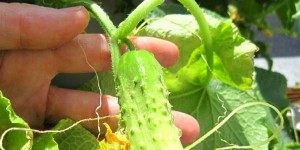 Welcome to my guide on how to grow cucumbers!
Welcome to my guide on how to grow cucumbers!
Learning how to raise cucumbers and how to ripen cucumbers can be lots of fun, is not terribly difficult, and can be very rewarding.
You can even learn how to grow cucumbers indoors!
There is nothing quite like biting into a fresh cucumber you have just picked off the vine, or opening a jar of pickles that are bursting with crunchiness and delicious dill flavor months after your garden has been put to bed for the winter.
Cucumbers are one of the great hot season plants that offer a wide variety of choices in size, texture, color, and appearance. Like heirloom tomatoes, cucumbers offer a wide variety of possibilities to add to your garden. There are varieties specifically bred to be small and knotted for pickling, and others that grow long and sweet for salads and cooking. There are cucumbers that you can pick all summer long. There are exotic specialty varietals from India and Asia.
Once you learn how to grow cucumbers vertically on a trellis, cucumbers can be a lovely bookend to a garden bed. Grown in small hills, they can punctuate the spaces between your garden beds, especially if they are planted with flowers. I will explain how to grow cucumbers with flowers that are not only beneficial to them but also provide a beautiful contrast to them. With a bit of practiced care, you can grow dwarf varietals in pots on your apartment balcony or placed throughout your garden. Home grown cucumbers are great for your health and well being, and they won’t lose any of their nutritional value if they are arriving to your plate just a few hours after they have been picked in your garden.
This guide will provide everything you need to know how to grow cucumbers that are beautiful, healthy, crispy, and bursting with flavor. First, I will provide an overview of the different groups of cucumbers. You will learn how to grow cucumbers bred for pickling and slicing as well as how to grow cucumbers bred for containers, or specialty cucumbers with interesting and unique flavors and colors. Then I will explain the best conditions for how to grow cucumbers, including soil, sun, and water. Next I will discuss how to plant cucumbers and the various options available to the gardener who is just learning how to grow cucumbers. Following that is a section on cucumber care and maintenance. This section has parts on what plants are best grown in tandem with cucumbers, how to fertilize, mulch, and compost for your cucumbers, watering techniques and how to deal with cucumber beetles and disease. Finally there is a section on harvesting your cucumbers and preserving them by pickling, followed by a brief conclusion. Let’s get started!
1. Types of Cucumbers
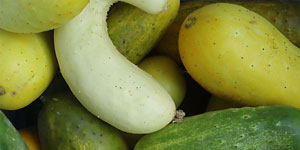 Cucumbers are organized into a few different groups. These are pickling cucumbers, slicing cucumbers, and container cucumbers. The names are self-explanatory. The pickling varietals are bred to be canned in brines to make pickles. They are typically shorter, with more tender skin that is bumpy and prickly. Slicing cucumbers are bred to be larger and sliced for salads and main dishes. They are typically smooth, dark green in color, long, and somewhat tough skinned. These categorizations are not set in stone, of course. You can actually use younger slicing cucumbers for pickling recipes, just as pickling cucumbers can be sliced up for summer salads.
Cucumbers are organized into a few different groups. These are pickling cucumbers, slicing cucumbers, and container cucumbers. The names are self-explanatory. The pickling varietals are bred to be canned in brines to make pickles. They are typically shorter, with more tender skin that is bumpy and prickly. Slicing cucumbers are bred to be larger and sliced for salads and main dishes. They are typically smooth, dark green in color, long, and somewhat tough skinned. These categorizations are not set in stone, of course. You can actually use younger slicing cucumbers for pickling recipes, just as pickling cucumbers can be sliced up for summer salads.
Container cucumbers include any varietals bred to be grown in pots and other containers. Cucumbers fall into two growing categories in addition to the ones mentioned above. Some grow on climbing vines, while others grow on bushes. Those that grow on bushes include some varietals that make relatively small, compact bushes that may be grown in containers on one’s patio or balcony. There are also dwarf vine varietals that will do well in containers. The following table lists a number of different varieties, along with their time to harvest and attributes.
- Bush Champion (Slicer): Compact, ten inch fruit, good for containers.
- Salad Bush (Slicer): Small vines, eight inch fruit, disease resistant.
- Sweet Success (Slicer): Burpless, 12 to 14 inch fruit.
- Piccolino (Slicer): Miniature English variety, 4 to 5 inches.
- Saber (Slicer): Dark green, long and slender, thick skins, 8-9 inches.
- Green Finger (Slicer): 8-10″ long, alpha type, thin skin, exceptional flavor.
- Calypso (Pickling): All-female with exceptional yields, very uniform, blocky 3×1 inch fruits.
- National Pickling (Pickling): 6″ long, good for pickling and eating fresh, short and thick with blunt ends.
- Little Leaf (Pickling): Compact vines are multi-branched, climb easily, medium sized smooth fruits, good for containers.
- Adam Gherkin (Pickling): Full and even shape with minimal tapering, dense flesh.
- Suyo Long (Specialty, Asian): Asian burpless, grows up to 15″, sweet and crisp, good for fresh eating, pickling, and cooking.
- Poona Kheera (Specialty, Asian): From India, great flavor, light-yellow when you and turns russet brown at maturity, best on trellis.
- Boothby Blonde (Specialty): Unique creamy-yellow skin and small black spines, plumb and oval shape, sweet, delicately flavored, attractive fruits.
- Lemon (Specialty): 3 inch round, delicate flavor, crunchy, easy to grow, does well in short growing season and in cool conditions, does well in containers.
2. Optimal Growing Conditions
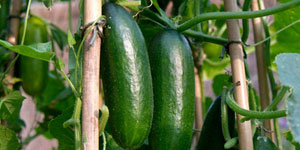 The best location for how to grow cucumbers that will grow well is one that is warm, receives plenty of sun, and has nutrient rich, well drained soil. The soil should be neutral to alkaline (basic), with a pH between 6.0 and 7.0 being optimal. You can test the soil pH with kits available at your local garden center or online. If the soil is too basic (higher than 7.0), you can amend it with oak leaves; if it is too acidic (lower than 6.0), you can work lime into it. See the guide to vegetable gardening for more on soil pH.
The best location for how to grow cucumbers that will grow well is one that is warm, receives plenty of sun, and has nutrient rich, well drained soil. The soil should be neutral to alkaline (basic), with a pH between 6.0 and 7.0 being optimal. You can test the soil pH with kits available at your local garden center or online. If the soil is too basic (higher than 7.0), you can amend it with oak leaves; if it is too acidic (lower than 6.0), you can work lime into it. See the guide to vegetable gardening for more on soil pH.
Cucumbers are a hot season crop, and therefore need plenty of sun and heat to grow well. Be sure to take note of the amount of sun the location you are planting them in receives throughout the day. Hot season crops need at least eight to twelve hours of full sun every day throughout the growing season. If no one location in the garden receives enough sun for hot season crops, consider growing dwarf varieties in pots that you can place on walkways or balconies that get full sun or else move around the garden during the day.
Cucumbers need lots of water to grow well. I will discuss watering techniques in the Maintenance section, but it is worthwhile to mention here that they should be planted near a reliable water source. If your location receives a lot of rainfall during the growing season, this is not as important of a concern, but whether it does or not, every area is susceptible to drought. If drought conditions threaten to persist in your area, you will need to be able to water your cucumbers and other hot season crops yourself. Hopefully there is a running water source available, but if not, you should consider obtaining a rain barrel. A rain barrel is a water collection barrel that attaches to the downspout of a building’s gutter system. Rain barrels can be constructed from regular barrels or plastic drums, or specialized rain barrels can be purchased at garden centers. Collecting rainwater is a wise precaution to take against droughts.
3. How to Plant Cucumbers
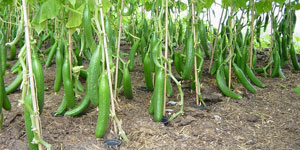 When you are first learning how to grow cucumbers, you will need to determine which method is best for your needs. You can grow cucumbers a variety of different ways. The method you decide for how to grow cucumbers will be influenced by a number of factors, including what kind of variety you choose to plant, the amount of space available to you, and whether you have a garden to grow them in or are growing them on an apartment balcony or patio. If you have enough space to grow cucumbers in a garden, you can plant them in rows, hills, or raised beds. You should bear in mind that cucumbers are very prolific plants. A single plant will yield a lot of cucumbers, and there are certain varietals that can continue to produce all summer long if you continually pick them. Therefore you should consider spacing out your plantings to allow you to harvest them all season.
When you are first learning how to grow cucumbers, you will need to determine which method is best for your needs. You can grow cucumbers a variety of different ways. The method you decide for how to grow cucumbers will be influenced by a number of factors, including what kind of variety you choose to plant, the amount of space available to you, and whether you have a garden to grow them in or are growing them on an apartment balcony or patio. If you have enough space to grow cucumbers in a garden, you can plant them in rows, hills, or raised beds. You should bear in mind that cucumbers are very prolific plants. A single plant will yield a lot of cucumbers, and there are certain varietals that can continue to produce all summer long if you continually pick them. Therefore you should consider spacing out your plantings to allow you to harvest them all season.
As mentioned in the second section, cucumbers can grow on bushes or on climbing vines. See the list in that section for which types of cucumbers are best to grow in pots and planters. Vine cucumbers grown in containers will require a trellis, especially if you are growing them on a balcony or patio. Trellises are also useful for vine cucumbers that you are growing in garden beds, as this method allows for more space in your garden by bringing vines up off the ground. Trellising your cucumbers will allow you to space them more closely together or more easily utilize the companion planting techniques described in the next section.
Cucumbers can be planted in rows once the soil temperature has reached seventy degrees Fahrenheit (21 Celsius). Rows should be spaced at least six feet (2 meters) apart, and individual plants in each row should have at least 2 1/2 feet (76 cm) between them. Different varieties will require different amounts of space, so be sure to check the seed packet or cultivation information provided with your seedlings before you plant them. If you are growing smaller varietals, you will be able to fit more plants into a smaller space. Certain varieties need as little as eight to ten inches (20-25 cm) between plants. Whatever the distance your plants require between them, it should be measured from the central stalk of each plant to the next when you first put in seedlings.
Because cucumbers are a warm season plant, they will do quite well if you sow seeds directly into the soil, which is useful when you are learning how to grow cucumbers, as it reduces the initial cost involved. If you are planting cucumbers in rows, sow the seeds about six inches (9 cm) apart. When the seedlings have become established – that is, they have grown their second set of leaves – thin them to the space suggested on the seed packet. If you sow your seeds about six inches apart initially, you should have a good amount that sprout successfully so that you can thin them.
Many different kinds of vine crops, like cucumbers, squash, and melons, do very well when planted in individual hills. This is not simply mounding the soil around the plant’s roots to improve water retention. The idea is more to start the tap root in the center of a hill of soil, allowing it ample room to grow outwards. This allows the roots to draw more water and soil nutrients, and prevents them from having to compete with one another. Vine crops that produce larger fruits need plenty of water, so the hill system is ideal for these plants. Hills should be spaced about three feet (1 meter) apart. Plant five to seven seeds in each hill, again about six inches (9 cm) apart. Once the seedlings have established as described above, thin them to just three plants. To thin them, simply snip off the seedlings you do not intend to keep. This will make sure you do not disturb the root system beneath the soil.
Both bush and vine cucumbers can be planted in raised beds. I have often described the benefits of planting vegetables in raised beds in previous garden guides. One of the major benefits to using raised beds to grow cucumbers is soil drainage. Generally speaking, raised beds will allow for well drained soil. They also provide more space than simply planting into the flat surface of the garden soil, and allow you to make a carefully constructed ecosystem below the ground that will be rich in nutrients and beneficial organisms. Raised beds require less watering and also make it easier to control harmful pests and weeds. Please refer to my guides on vegetable gardening and organic gardening for more about how to build and maintain raised beds.
As I mentioned earlier, cucumber varietals that grow on vines should be trellised. Not only does this provide more space in your garden by preventing the vines from meandering through it and taking over the rest of the bed, it is also better for them. Cucumber vines that are kept off the soil will not find themselves sitting in pools of water after rainstorms or when they are watered. This will prevent them from experiencing leaf rot and protect them from a number of diseases and pests. By trellising your vines, you can control what portion of the plant is in contact with the ground. This makes it much easier to prevent cucumber beetles from reaching the plants’ vulnerable parts. Trellises can be purchased at garden centers, although they can be expensive. You can find inexpensive ones at garage sales, or you can make your own. A simple trellis is easily constructed from wooden posts and twine. See the section on Vertical Gardening and Other Projects in my Vegetable Gardening Guide for instructions on how to grow cucumbers on a simple trellis.
4. Maintenance
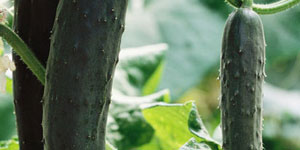 Like any vegetable, cucumbers can benefit greatly from being grown using companion planting methods. Companion planting is the practice of growing plants in tandem with one another in mutually beneficial relationships. For example, plants that take lots of nitrogen from the soil can be planted with those that return nitrogen to the soil. Lightweight climbing plants can be planted among corn and other tall, sturdy plants that act as a natural trellis. Plants that need shade can be planted around or behind taller ones that will provide it.
Like any vegetable, cucumbers can benefit greatly from being grown using companion planting methods. Companion planting is the practice of growing plants in tandem with one another in mutually beneficial relationships. For example, plants that take lots of nitrogen from the soil can be planted with those that return nitrogen to the soil. Lightweight climbing plants can be planted among corn and other tall, sturdy plants that act as a natural trellis. Plants that need shade can be planted around or behind taller ones that will provide it.
In the case of cucumbers, there are a few different types of plants that prove beneficial if grown with them. Cucumbers require a good deal of nitrogen to grow well, so most beans, which host nitrogen-fixing bacteria. It is useful to plant beans and vine cucumbers together, as they can share a single trellis. Corn can serve as a natural trellis for more lightweight vine cucumbers.
Radishes can be grown with cucumbers as a trap crop for beetles. Dill, nasturtiums, petunias, marigolds, tansies and sunflowers also help to repel cucumber beetles and attract beneficial insects that prey on these pests. See the portion on Insects and Diseases in this section for more about planting flowers and herbs that are beneficial to cucumbers.
4a. Organic Fertilizer And Mulch
If you want to know how to grow cucumbers that are rich in flavor and consistently healthy, he best way to fertilize your cucumber garden is via organic means. This can be accomplished by mulching, composting, and applying manure in generous quantities. These methods make for sustainable and inexpensive fertilizer. I highly recommend them for vegetable gardening, as they will keep the chemicals of synthetic fertilizer out of your garden, off your table, and out of your body. I have described how to construct a proper compost pile in previous guides. Here is a brief overview of excellent organic additions to the compost pile. These can also be mulched directly onto the garden bed or tilled into the soil as organic fertilizers.
Grass clippings are a readily available material containing abundant nitrogen. If you leave a pile of grass clippings alone for a few days, you will find that it gets very hot in the middle. This heat is generated by decomposition. Green grass clippings need to be mixed with a drier, more absorbent material when you are applying them you your garden beds as compost. Otherwise they tend to become compacted and prevent air circulation. When this happens the moisture in grass clippings can turn the compost into a wet, brown mess. You can either dry out the grass clippings before adding them to the garden, or mix them with dry leaves or wood shavings.
Weeds and general garden detritus are great compost and mulching material. Most plants accumulate certain minerals in particular; for example, dandelions accumulate calcium. Shredded weeds can be used to return minerals to the soil as fertilizing mulch. Yard waste can be saved for your compost pile and for mulching anyplace where it is dry. As long as your yard waste is kept dry, it will not begin to decompose until it is prepared for and added to the fertilizer pile.
Manure should be applied generously to the garden beds. Manure is one of the best organic fertilizers. Manure supplies not only nitrogen but also a healthy population of bacteria that work as decomposers. Manure can also be acquired for free from riding stables or dairy farms. If you live in a large city in which carriage rides are offered to tourists, you might try the carriage company’s stables for free manure. Garden centers also sell various kinds of manure at fairly low prices. You should consider a mix of manure for your garden, including cows, horses, and chickens. Chicken droppings are particularly high in nitrogen. Manure can also be stored anyplace where it is dry. However, some kinds of manure can attract rats, which eat animal droppings. Therefore if you are storing manure, do so in a manner that protects it from vermin. Otherwise, only acquire manure when you are about to use it.
4b. Water
Simply put, your cucumbers are thirsty plants that need a lot of water. Keep the soil well moistened throughout the entire growing season. It is important when you are selecting a growing site to be certain it is one that will have access to an ample supply of water, especially if you live in an area that does not get much rainfall during the growing season. Mulch soil generously as described in the previous section, as this will help keep the soil from drying out as quickly as it otherwise would after watering.
Be especially vigilant about watering from the time the fruit begins to swell and ripen. Inadequate watering and watering inconsistently will result in fruit that is weirdly shaped and tastes bitter. Water plants early in the morning, before the sun has gotten hot, or in the evening as it is low in the sky.
It is best to use drip irrigation or belowground watering techniques. Drip irrigation uses porous hoses or tubes that are buried just beneath the surface of the soil and connected to a water reservoir. They slowly seep water into the soil, keeping it evenly moistened. Thorough instructions for constructing and installing drip irrigation systems are included in the guide on Growing Vegetables. Sprinkling is not recommended, as it can encourage the growth of downy mildew on the cucumbers’ leaves.
4c. Pests And Diseases
The cucumber beetle is the number one enemy of cucumbers, especially the American Midwest and East. The beetle is small –only about 1/4 inch (1/2 cm) long, and is typically either spotted or striped. It is attracted to cucumbers by the scent they produce, the chemical name of which is cucurbitacin. Mature cucumber beetles will ravage flowers and leaves of your cucumber plants, while the larvae feed on the plants’ roots. Not only do they eat the plants, they also can infect the cucumbers with a disease called bacterial wilt. There is no cure for bacterial wilt, which blacks the flow of water from the plant’s roots up through its stem. Infected plants begin to wilt almost immediately and die within only a few days. While cucumber beetles are not guaranteed to be carrying bacterial wilt, and first has to come in contact with it – usually from otherwise healthy-looking weeds – the risk of wilt is present whenever cucumber beetles are.
The youngest seedlings are always the most at risk to damage from striped cucumber beetles. Once your plants have developed a few pairs of true leaves (other than its initial pair of seed leaves) it can tolerate a considerable degree of injury to its leaves before it is in serious trouble. You can protect young plants a few different ways. You can cover them with a layer of light row cover made of breathable polyester or cotton. You can also cut the ends off of a milk jug and place it over the plant as a kind of protective collar. Keep your beds free of weeds, which can carry bacterial wilt, and be on the lookout for the spotted or striped beetles. And trellis your cucumbers that grow on vines to keep as many flowers and leaves as inaccessible as possible to these pests.
You can make your garden beds inhospitable to cucumber beetles by introducing plants and beneficial predatory insects. As mentioned in the section on companion planting, there are a number of flowers that will make cucumber beetles less likely to make your garden their home. These include nasturtiums and petunias, which will repel the cucumber beetles, and marigolds, calendula, daisies, sunflowers, dill, and alyssum to attract predatory insects to eat the intruders. These plants will attract green lacewings, and ladybugs, which will attack the larvae of cucumber beetles. Planting dill has the added benefit that you can use it for making pickled cucumbers, as described in the next section!
It can also be useful to invest in beneficial nematodes, which will also attack the eggs and larvae of cucumber beetles in the soil. You can purchase supplies of beneficial nematodes online or at garden centers. Apply them when the soil is moist, well after the last frost but still early in the growing season. The nematode media should be mixed with water and applied with a watering can. Reapply again later in the season if you plant a bumper crop of cucumbers or if you are experiencing a particularly bad cucumber beetle infestation.
5. Harvesting Cucumbers
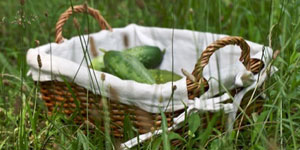 Depending on what variety you are growing, your cucumbers will be ready to be harvested between fifty and seventy days from planting. As you learn how to grow cucumbers, you will find that the more often you pick your cucumbers, the later into the growing season they will continue to produce. This is because they belong to the squash family; if you have ever grown zucchini, you will know a thing or two about letting the fruits of squash plants get too big. You will be able to yield longer lasting harvests of high quality cucumbers on plants that remain productive if you pick the cucumbers frequently and before they grow too big.
Depending on what variety you are growing, your cucumbers will be ready to be harvested between fifty and seventy days from planting. As you learn how to grow cucumbers, you will find that the more often you pick your cucumbers, the later into the growing season they will continue to produce. This is because they belong to the squash family; if you have ever grown zucchini, you will know a thing or two about letting the fruits of squash plants get too big. You will be able to yield longer lasting harvests of high quality cucumbers on plants that remain productive if you pick the cucumbers frequently and before they grow too big.
When you learn how to grow cucumbers, you will find that size matters. That is to say, the size you should allow your cucumbers to grow before you harvest them depends on the variety you are growing. For the best taste and texture, American varieties of slicing cucumbers are usually best if you harvest them when they are six to eight inches (fifteen to twenty cm) long. Varieties from the Middle East, such as Amira, should be harvested at four to six inches (ten to fifteen cm) long. Most pickling cucumbers may be harvested at three to five inches (seven to twelve cm) long, although you should also take care not to let them get too long for the jars you intend to use for pickling them. Asian varieties such as Japanese cucumbers can be picked when they are eight to twelve inches (twenty to thirty cm) long.
The Middle Eastern or Mediterranean cucumber varietals are shorter and stockier in shape than their American counterparts. Asian varieties such as “Tasty Jade” are quite long and slender, and can grow as much as fifteen inches (forty cm) in length. Consult seed packets or experts at your local garden center for advice on when to harvest particular varietals for best results.
You will find that different gardeners utilize different methods for harvesting individual cucumbers, and you will need to learn which one is best for you. Some people harvest their cucumbers by twisting the fruit until it snaps off, or bending the fruit towards the stalk until it snaps. It does take some skill to learn how to harvest cucumbers by making a clean break in this fashion. If you are not comfortable trying this method, you can use a pair of scissors or pruning shears instead. Hold the cucumber in one hand and cut the stem about a quarter inch (1/2 cm) above it.
Your fruit may taste somewhat bitter when you harvest it, but if this is the case there is no need to worry. Bitterness usually is concentrated in the end closer to the skin as well as the skin, and should not penetrate too far into the center of the cucumber. If you find that the cucumber is bitter, slice off the end closest to the stem and peel the fruit. This should reduce the bitter flavor.
5a. Preserving Your Harvest
Pickling is by far the most common means of preserving cucumbers. We will concentrate on discussing how to pickle cucumbers in this section. If you are interested in learning how to pickle cucumbers, begin by choosing a pickling variety to grow. Some are listed above in the section on Types of Cucumbers, but seed catalogues will also let you know if a varietal is a pickling cucumber or a slicing cucumber.
As mentioned in the previous section, you should harvest your pickling cucumbers when they are no more than four or five inches long. Pickling cucumbers that are allowed to grow any longer tend to become somewhat flabby in the middle. This will prevent them from maintaining a satisfying crunchiness when pickled. Pickling cucumbers also do not have a particularly long shelf life when they are kept in the fridge. They will respire through their skin, dry out, and tend to get wrinkled. Therefore it is important to pickle them very soon after you have harvested them.
Before you begin, soak the pickling cucumbers in an ice water bath for four to five hours. This helps to maintain their crispiness when they are being pickled. There are two methods that you can use to pickle your cucumbers. The first, called “refrigerator pickling,” is short-term, and allows you to quickly produce crunchy pickles, but these pickles will not have a long shelf life and will need to be kept in your fridge and eaten within three or four weeks. This is a good method to use when you first learn how to grow pickles and have not yet learned how to can them. The second method, a traditional canning method, is a bit more involved but produces pickles in an airtight jar that will last for months on the pantry shelf. It requires specialized equipment and more time, but the principles of canning can be worthwhile to learn, as they are applicable to a broad range of other vegetables as well.
5b. Refrigerator Dill Pickle Recipe
Ingredients: 3.5 cups water, 1.25 cups white vinegar, 1 Tbsp kosher salt, 1 Tbsp sugar, pickling cucumbers sliced into spears or coins, unpeeled, 2 cloves fresh garlic, and 2 heads fresh dill.
Instructions: Bring the water and vinegar to a boil in a heavy saucepan. Add the salt and sugar and wait for it to dissolve. Remove from heat. Place pickling cucumbers, garlic, and dill in a jar. Pour liquid over them. Cover and place in refrigerator. Pickles will be ready in three or four days and remain good for about at month.
5c. Canning Pickled Cucumbers Recipe
Equipment: Quart Ball jars with new lids and clean rings, canning rack, canning pot (or canner).
Ingredients: 8 pounds of pickling cucumbers, 2 quarts of water, 1.25 cups pickling salt, 1.25 quarts white vinegar (5%), 1/4 cup sugar, 2 Tbsp pickling spices, 3 Tbsp whole mustard seed, two bunches of fresh dill.
Instructions: Begin by washing the jars and preparing them according to the manufacturer’s specifications. This will involve sterilizing them in the canner by boiling them while covered for 15-20 minutes. It is very important to complete this step thoroughly in order to kill any bacteria that are latent in the jars, or you run the risk of ruining your pickles or making yourself sick.
Dissolve pickling salt and sugar in boiling water. Add vinegar and bring back to a boil. Distribute pickling cucumbers, spices, dill, and mustard seed in sterilized jars. Make sure there is at least an inch of space between the cucumbers and the threading of the mouth of the jar. Cover pickles and dill with boiling liquid, leaving about a half inch of head space. Adjust lids and screw on rings. Process the jars by covering them in boiling water in the canner. Refer to the manufacturer’s specifications for the amount of time the pickling jars will need to be processed. Do not tighten the rings. After the jars have cooled for twelve to twenty four hours, remove the rings. Dry the jars, label them, and store in a cool, dry, place. The pickles are best if eaten within a year, but will remain safe to eat as long as the lids stay vacuum sealed.
Homemade pickles make lovely small gifts for friends and family, and are a fun addition to potlucks and dinner parties. You can experiment with different recipes to make spicy pickles, dill pickles, and sweet pickles with all kinds of flavors.
6. Final Word
 I hope this guide has been as informative for you to read as it was enjoyable for me to write. In it we have learned a number of things about how to grow cucumbers. We have learned about the different kinds of cucumbers out there, the best ways to plant and care for them, and how to preserve them after the harvest. By now you should have some idea of what kind of cucumbers you are interested in growing, as well as how to best go about doing so. Growing cucumbers can be a wonderfully enjoyable and rewarding experience, and learning how to grow cucumbers is not a particularly difficult endeavor. Cucumbers are a prolific enough plant that you should be able to enjoy the experience of bringing them to your own table or sharing them with friends.
I hope this guide has been as informative for you to read as it was enjoyable for me to write. In it we have learned a number of things about how to grow cucumbers. We have learned about the different kinds of cucumbers out there, the best ways to plant and care for them, and how to preserve them after the harvest. By now you should have some idea of what kind of cucumbers you are interested in growing, as well as how to best go about doing so. Growing cucumbers can be a wonderfully enjoyable and rewarding experience, and learning how to grow cucumbers is not a particularly difficult endeavor. Cucumbers are a prolific enough plant that you should be able to enjoy the experience of bringing them to your own table or sharing them with friends.
Now it’s your turn to apply everything I explained about how to grow cucumbers!

